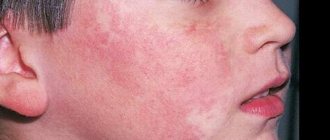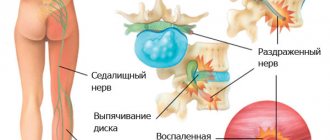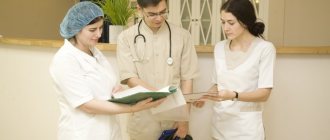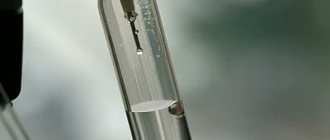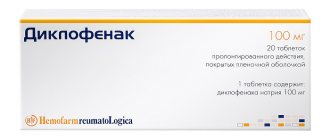Causes of lumbodynia - why did this happen to you?
Doctors say that lower back pain is the consequences of osteochondrosis and “humanity’s retribution for walking upright.” And this is also the price to pay for a “sofa” lifestyle, a love of fast food and a passion for late dinners, for neglecting physical activity and inattention to oneself. Any of these reasons can lead to a sudden attack of lower back pain.
Therefore, if you:
- - feet were frozen and wet,
- - were in an uncomfortable position for a long time,
- - they suddenly lifted something heavy,
- — decided to go in for sports “from the heart”, although they were not used to such loads,
- - you suffer from flat feet and have put a lot of stress on your legs,
then in a couple of days it may “shoot” in the lower back.
Diagnosis of lumbodynia
The main differential sign of lumbodynia, among other spinal problems, is a symptom of muscle tension, accompanied by pain. Correspondence of the localization of reflected pain during palpation to certain trigger points. There is no muscle atrophy in this disease, and when the nerve trunk is compressed, neurological symptoms are revealed. Diagnosis is important in order not to miss serious diseases of the spine and spinal cord. The doctor makes the final diagnosis based on research results, obtaining complete information about the pathology. Thus, treatment for symptoms of lumbodynia will depend on the cause of the disease and may vary depending on the duration of the clinic and the intensity of the pain.
During the consultation, the patient’s symptoms and complaints are discussed; during the examination, the doctor determines the localization of pain, identifies positions that aggravate and alleviate pain, examines the neurological status, muscle strength in the pathological area.
Additional studies may be used for diagnosis:
- X-ray – to determine the most obvious causes of lower back pain: fractures, age-related changes, curvature or deformation of the spinal column or its deformation.
- MRI - using magnetic resonance imaging, high-quality images of soft tissues of the spine, such as muscles, nerves, intervertebral discs, can determine intervertebral hernia, infectious diseases or tumors.
- CT - using three-dimensional computed tomography images, the condition of the bones is determined.
- Densitometry - a method that examines bone density, is prescribed for suspected osteoporosis, which does not cause low back pain in itself, but may be the cause of a compression fracture that causes pain
- EMG - electromyography and ENMG - electroneuromyography - examination methods for detecting disturbances in the transmission of nerve impulses to nerve fibers and muscles.
- Lab tests.
Get a free consultation by phone
Symptoms of lumbodynia - how to recognize the disease?
Acute lumbodynia usually appears on one side. The pain intensifies if you stand or sit, and disappears if you lie on your side. Your lower back hurts even if you perform normal movements, such as washing your face. The pain gets worse when you cough or sneeze; bending over is difficult and painful. Muscles get tired quickly if you sit or stand. You have to change your position frequently to reduce the pain.
The pain increases by the 4-5th day of the attack. Treatment should begin as soon as they appear. Otherwise, this condition will drag on for weeks. If the process becomes chronic, the sacrum, buttock, and leg already hurt. You shouldn’t let it get to this point - chronic lumbodynia takes much longer and is more expensive to treat.
Causes
The cause of lumbodynia may be:
- excessive, unusual load for the body when lifting weights;
- sudden, so-called unprepared, movements on “cold” unheated muscles and joints;
- hypothermia;
- smoking as a background factor;
- psycho-emotional overstrain - stress.
Lumbodynia - pain in the lumbar spine, as a rule, appears against the background of existing osteochondrosis. Due to degenerative processes of the spine, and especially the intervertebral discs, which are characteristic of this disease, the distance between the vertebral bodies decreases, resulting in muscle spasm and lumbodynia.
How is it usually treated, and is there another option to get rid of vertebrogenic lumbodynia?
If you go to a “regular” neurologist, you will be prescribed a list of medications - for pain, inflammation and swelling, vitamins to nourish the nerves. Physiotherapy may be prescribed. Plus, the standard is blockade with hormones. Yes, after them it becomes easier for a while. However, there is another side. If you make more than 5 injections, the body gets used to hormones “from the outside” and produces less of its own.
There are safe and effective replacements for hormones and medications harmful to the stomach, liver and kidneys. No medications. Studies have proven that osteopathy, acupuncture and massage are as effective as medications. The pain goes away after 1-2 sessions, and by the end of the course of treatment you can return to normal life.
Which doctors treat:
We recommend that you first make an appointment with your primary care physician. He will carefully examine and interview you, perform muscle tests and confirm the diagnosis. If an MRI, ultrasound or x-ray is needed, he will refer you for examination. Next, he will prescribe a course of treatment and select the right treating specialist: an osteopath, reflexologist or massage therapist. The consultation will take about 30 minutes; if you stay for treatment on the same day, it will be free.
You can make an appointment with a primary care doctor right now:
Diagnostics
The basis for diagnosing lumbodynia is the patient’s complaints, as well as detailed questioning about the moment of pain onset and its nature.
A detailed examination of the lumbar region is carried out with palpation of the spinal zone, muscle corset and sacral area in the projection of the nerve roots. In order to exclude non-vertebral problems, the following is carried out:
- general blood and urine analysis, biochemical blood test, blood for antibodies to infections,
- x-ray of the lumbosacral spine,
- MRI or CT scan of the spine in the lumbar region to determine anatomical defects and the condition of the intervertebral discs,
- Ultrasound of the abdominal and genital organs,
- consultations with additional specialists (therapist, infectious disease specialist, gynecologist or urologist).
How can we help when we have a pain in the back?
Method No. 1. Osteopathy acts gently and effectively
Pain with lumbodynia causes many unpleasant minutes. Few people want to experience uncomfortable sensations during treatment. Osteopathy helps to comfortably get rid of pain and spasms, restore range of motion, and improve overall well-being. Many people do not understand how such a result can be achieved with soft and imperceptible movements. The secret is in special techniques that the doctor uses to restore the balance between bones, ligaments, muscles, tendons, and internal organs. The pain goes away, movements become free.
Method No. 2. Acupuncture - needles heal
This is one of the most effective methods of combating lower back pain. If you insert needles into the right points, you can reduce pain, swelling and inflammation, remove muscle tension and restore the ability to move freely. Needles act not only on the spine and nervous system, but also improve the functioning of internal organs and affect the general condition. Treatment begins only after a thorough diagnosis. The doctor selects points for treatment: both directly around the painful area on the lower back, and distant ones - on the arms, legs, even on the auricle. Needles are inserted into them in a certain way and for a certain time. You may experience minor discomfort at first. However, by the end of the course, most patients get rid of pain.
Method No. 3. Massage in the chronic phase
What is the difference between acupressure therapeutic massage? Firstly, the effect. Because it is done point by point. Thanks to this approach, it affects the entire body, eliminates muscle spasms and swelling, and not only causes a rush of blood to the skin. Secondly, the time of exposure. An acupressure session lasts half an hour to an hour, not 10-15 minutes. Thirdly, sensations. The first sessions may be painful, but gradually the pain disappears. Instead of the classic method of working on points, the doctor may choose cupping or gouache massage. If you combine massage with acupuncture, the effect comes faster. Those who are looking for how to treat lumbodynia of the lumbosacral vertebra without hormones will appreciate this method.
Method No. 4. Laser enhances the effect
Low-level laser light has been used to treat low back pain for as long as needles, massage therapy and osteopathy. However, the effect of the laser appears already in the first sessions. The doctor selects painful areas, nerve exit points, and areas of spasmed muscles. The maximum you feel is a slight warmth and pressure. Almost everyone can use the laser - the elderly and frail, those who are afraid of needles, those who have damaged skin at the site of exposure.
Method No. 5. Homeosynia relieves the condition
If you administer HeL drugs in the form of microinjections into biologically active points, then pain and swelling go away faster. This procedure complements acupuncture, massage, osteopathy and laser radiation. And it has no side effects.
How to cure lumbodynia
When pain occurs, the patient is prescribed rest. It is necessary to lie in bed more and avoid sitting. Until the pain disappears, you need to wear a special orthopedic belt that will support the vertebrae in the correct position.
If the pain is very severe, then strict bed rest is prescribed for 7-10 days. The patient is recommended to lie on his stomach more often. When a person lies on his back, a special circle or a terry towel rolled into a ring is placed under his lumbar region.
We advise you to study – Spinal Kyphosis
The pad allows the affected area of the spine to be supported. Place a pillow or rolled blanket under your feet. Elevated legs reduce the load on the spine and help return the vertebrae to their normal position.
To eliminate severe pain and reduce inflammation, non-steroidal anti-inflammatory drugs (Diclofenac, Ibuprofen, Ketoprofen, Meloxicam) are prescribed. It is recommended to give injections on the first day. The drugs are then taken orally. The tablets should be taken during or immediately after meals, with plenty of water. If the patient has diseases of the digestive system, therapy is carried out in the form of injections. Ointment (Diclofenac, Ibuprofen) is applied to the lumbar region 2-3 times a day.
The duration of treatment with non-steroidal anti-inflammatory drugs depends on the duration of lumbodynia. For severe radicular pain, you need to take 1 type of drug for at least 3-4 weeks.
Excruciating pain is relieved using paravertebral blockades with anesthetics (Lidocaine, Procaine) in combination with hormonal drugs (Dexamethasone, Hydrocortisone).
He is prescribed:
- gentle manual therapy techniques;
- massage;
- acupuncture;
- spinal traction;
- physical therapy.
Price at East Clinic
Treatment of lumbodynia is 5-7 complex sessions, each of which consists of a combination of procedures. For example, osteopathy, acupuncture and massage, laser or any others. You also receive additional recommendations on diet, regimen, and exercise.
Price:
- - treatment session 60 minutes - from 4,500 rubles to 5,900 rubles, depending on the category of specialist.
The initial doctor's appointment is free, if treated on the same day. When you pay for the full course you receive a discount of up to 15%.
Why should we treat you for lower back pain? There are 5 reasons for this:
Reason #1 - individual course.
Each patient is unique, and the doctor selects the course based on the severity of the process, the intensity of pain and “companion” diseases. We have enough methods in our arsenal to ensure you get the desired result.
Reason #2 - result.
You don’t have to come to us “like going to work” - we do several procedures in one visit, saving you time, money and alleviating your condition. This approach has shown its effectiveness - in most patients, pain goes away after the first course. There are patients who need more time to recover. In such cases, we convene a consultation and involve leading specialists.
Reason #3 - guaranteed security.
You will first be thoroughly examined, a diagnosis will be made, contraindications will be excluded, and only then a course of treatment for vertebrogenic lumbodynia will be prescribed. If an MRI is needed, the doctor will inform you. If you have already been examined and treated, take medical documents to your appointment: extracts, reports, outpatient records.
Reason No. 4 - teamwork of specialists.
Our medical specialists, diagnosticians and clinicians have already reached a high level. They all work together to achieve the desired result, have undergone internships in leading public clinics and private centers, and are constantly improving their skills and skill level.
Reason #5 - performance control.
This is done by the primary care physician during the course of treatment. Interim, final and control appointments are free and allow you to fully control the progress of treatment. We exclude situations where the course is completed, there is no result, and no one reacts to it.
If you “shoot” in the lower back, you should not endure it and self-medicate. If it doesn't help, you should find an alternative. We have experience, knowledge and capabilities. Don't let pain control your life. Call 8 (495) 153-52-14 and make an appointment. Take action now.
Clinical manifestations of lumbodynia
First of all, the clinical manifestations of lumbodynia are that the patient experiences pain in the lumbar spine from mild to intense, aching, exhausting, intensifying when trying to change body position, movements in the lower back, coughing, sneezing, straining. Pain in the lumbar spine can be diffuse or localized on one side or even at one point. The duration of the pain syndrome ranges from several minutes to chronic (permanent) forms.
Symptoms of lumbodynia - pain in the lumbar spine include the appearance of muscle tightness in the lumbar region. Pressing on them is very painful.
MRI of the spine
- Cost: 16,000 rub.
More details
The symptoms of lumbodynia manifest themselves especially strongly on the fourth or fifth day after the onset of the attack, and then begin to gradually weaken. During an attack, it is difficult for the patient to bend and unbend, and stand for a long time; he constantly wants to sit down or lie down. If lower back pain lasts more than six weeks, progressively intensifies, or is accompanied by elevated body temperature, sudden weight loss and injury, seek medical help immediately so as not to miss cancer.
Tests for coronavirus
- Test for coronavirus
- Coronavirus test for organizations
- Testing for coronavirus at home
- Testing for coronavirus at home in 12 hours!
- Testing for coronavirus in Lyubertsy in 12 hours!
- Testing for coronavirus in Nekrasovka in 12 hours!
- Testing for coronavirus in Korolev in 12 hours!
- Test for coronavirus on the Sokol metro station
- Coronavirus test at Kolomenskaya metro station
- Coronavirus test at Voykovskaya metro station
- Test for coronavirus in Nekrasovka
- Coronavirus test in Korolev
- Test for coronavirus in Lyubertsy
- Test for coronavirus in Mytishchi
- Test for coronavirus at home Mytishchi
- Test for coronavirus at home Korolev
- Test for coronavirus at home Lyubertsy
- Test for coronavirus at home Nekrasovka
